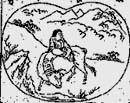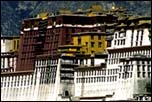http://www.rediff.com/news/dec/31rajeev.htm
The Buddhist Connection: Sabarimala and the Tibetans
 It is a winter phenomenon, starting in mid-November, at the beginning of the Malayalam month of Vrschikam (Scorpio), and lasting until mid-January. All over South India, you find pilgrims in the distinctive attire of the Ayyappan sect -- dressed all in black or blue, hirsute; singing songs in praise of the Lord of Sabarimala. They set out, after forty-one days of penance, on a long journey to the River Pamba and then a rugged trek to the sanctum.
It is a winter phenomenon, starting in mid-November, at the beginning of the Malayalam month of Vrschikam (Scorpio), and lasting until mid-January. All over South India, you find pilgrims in the distinctive attire of the Ayyappan sect -- dressed all in black or blue, hirsute; singing songs in praise of the Lord of Sabarimala. They set out, after forty-one days of penance, on a long journey to the River Pamba and then a rugged trek to the sanctum.
The appeal of Sabarimala, a remote and tiny temple in a valley in the Western Ghats of Kerala, has increased phenomenally in the last couple of decades; it is now believed to be the world's second largest annual pilgrimage in terms of the number of devotees, second only to the Haj in Mecca. It is a most unusual pilgrimage to a most unusual deity; for Sri Ayyappan is Hariharaputra, the Son of Lord Vishnu and Lord Siva -- and this is the only ancient temple to Him.
It is likely that the unusual myth of the Son of Vishnu and Siva is due to another historical event: a reconciliation between Saivite and Vaishnavite Hindus. Unlike other parts of the South, where the two were often in conflict, Kerala has typically seen harmony between them.
 I have been on the Sabarimala pilgrimage several times, and it is a remarkable experience: one is swept away by the palpable tide of faith all around one. The climb up from the Pamba riverbank to the sanctum is difficult: up steep slopes, through dense forests. Since you walk uphill barefoot, with a small sack on your head (a two part sack, representing one's deeds, both sins and good deeds), it is not easy: but the pilgrims chant that the sharp pebbles underfoot are as mere flowers.
I have been on the Sabarimala pilgrimage several times, and it is a remarkable experience: one is swept away by the palpable tide of faith all around one. The climb up from the Pamba riverbank to the sanctum is difficult: up steep slopes, through dense forests. Since you walk uphill barefoot, with a small sack on your head (a two part sack, representing one's deeds, both sins and good deeds), it is not easy: but the pilgrims chant that the sharp pebbles underfoot are as mere flowers.
And it is a very democratic pilgrimage: all the devotees address each other merely as 'Ayyappan'; class or caste or even religion is not at issue. Interestingly, the pilgrims pay obeisance at the shrine of the Muslim Vavar, apparently a friend of the historical Prince of Pandalam (a small kingdom) who has become identified with the deity in another legend. However, there is some controversy: women in their child-bearing years are not allowed to go on the pilgrimage. Personally, I find myself ambivalent on whether this restriction should be lifted: on any given day, I can argue either way.
There is considerable evidence that Lord Ayyappan was once a Buddhist deity, and that Sabarimala was once a Buddhist temple complex. However, it appears that prior to its Buddhist incarnation, the temple was an early Dravidian Saivite centre; therefore it has been a sacred spot of singular merit of at least three or four millennia. Its famed Makara Jyotis (Divine Light) which appears mysteriously in the forest on Makara Sankranti day gave it the name Potalaka.
 Astonishingly, it appears that the Dalai Lama's Palace in Lhasa, the incomparable Potala, is named after Sabarimala! The Bodhisattva (Buddha-to-be) Avalokitesvara Padmapani, the Bodhisattva of Compassion, who is, by tradition, reincarnated as the Dalai Lama, was also the one worshipped at Sabarimala.
Astonishingly, it appears that the Dalai Lama's Palace in Lhasa, the incomparable Potala, is named after Sabarimala! The Bodhisattva (Buddha-to-be) Avalokitesvara Padmapani, the Bodhisattva of Compassion, who is, by tradition, reincarnated as the Dalai Lama, was also the one worshipped at Sabarimala.
I am indebted to my cerebral friend Devakumar Sreevijayan (formerly of Austin, Texas and currently of New York City) for almost all of this fascinating research. It is in three texts: the Avatamsaka Sutra, the Hymn to the Thousand-Armed Avalokitesvara, and the writings of the intrepid Chinese traveller Hsiuen Tsang (Zuen Xang?), that we find the detailed references. Dev found a good deal of information in the book, The Thousand-Armed Avalokitesvara by Lokesh Chandra.
But there is ample circumstantial evidence for Kerala's Buddhist/Jain past. Unlike Nagarjunakonda in Andhra Pradesh and Sravanabelagola in Karnataka, they have left no large monuments in Kerala, but it is known that Kodungallur, for example, was a Buddhist centre. Kodungallur, at the time known as Muziris, was a major port; a Buddhist nunnery there became a great Devi temple later, associated with Kannagi, the heroine of the Tamil epic Silappathikaram (The Jewelled Anklet) written by the Chera Prince Ilango Adigal, who lived in what is now Kerala.
The revered Patriarch Bodhidharma (Daruma in Japanese) from Kodungallur was the originator of the Zen sect (dhyana in Sanskrit, Ch'anin Chinese) -- he went to the Shao-Lin monastery in China (420-479 CE), and he took the martial art of kalari payat there for the protection of the unarmed monks, whence the various martial arts of East Asia. According to Chinese legend, Bodhidharma also created the tea plant, by tearing off his eyelids and planting them in the ground: presumably this means he also took the tea plant with him.
 The legend of Mahabali -- the asura king sent to the underworld by an avatar of Lord Vishnu -- also gives clues to the Hindu-Buddhist past: an egalitarian Buddhist rule overthrown by Brahmin-led Upanishadic Hindus. Perhaps there was a period of co-existence, much like the centuries-old peaceful co-existence between the followers of the Buddha and Eswara/Siva in South East Asia. In the great temples of Java and Cambodia, Eswara/Buddha are almost seen as interchangeable.
The legend of Mahabali -- the asura king sent to the underworld by an avatar of Lord Vishnu -- also gives clues to the Hindu-Buddhist past: an egalitarian Buddhist rule overthrown by Brahmin-led Upanishadic Hindus. Perhaps there was a period of co-existence, much like the centuries-old peaceful co-existence between the followers of the Buddha and Eswara/Siva in South East Asia. In the great temples of Java and Cambodia, Eswara/Buddha are almost seen as interchangeable.
At Prambanan in Java (the Hindu counterpart to the great Buddhist complex at Borobudur) and at Angkor Wat in Cambodia, the images of Siva/Eswara and of the Buddha are sometimes intermixed; apparently there was no great animosity between the worshippers of both. Similarly, one might hope, the transitions from Siva to the Buddha to Ayyappan were relatively peaceful.
The circumstantial evidence for the Buddhist nature of Lord Ayyappan is compelling. For one, the devotees chant: "Swamiye saranam Ayyappa," so close to the Buddhist mantra: "Buddham saranam gacchami, Sangham saranam gacchami, Dhammam saranam gacchami."
Furthermore, the very sitting posture of the Ayyappan deity is suggestive: almost every Buddhist image anywhere, including those sometimes unearthed in the fields of Travancore by farmers, is in sitting position. Whereas practically no other deity in Kerala is in that posture.
Says Lokesh Chandra: 'The Avatamsaka Sutra describes the earthly paradise of Avalokitesvara: ''Potalaka is on the sea-side in the south, it has woods, it has streams, and tanks''...Buddhabhadra's (AD 420) rendering of Potala (or Potalaka) is ''Brilliance." It refers to its etymology: Tamil pottu (potti-) ''to light (as a fire)''...brilliance refers to the makara-jyoti of Sabarimala.'
 'Hsuen Tsang refers to Avalokitesvara on the Potala in the following words, summarised by Waters (1905): ''In the south of the country near the sea was the Mo-lo-ya (Malaya) mountain, with its lofty cliffs and ridges and deep valleys and gullies, on which were sandal, camphor and other trees. To the east of this was Pu-ta-lo-ka (Potalaka) mountain with steep narrow paths over its cliffs and gorges in irregular confusion...'' '
'Hsuen Tsang refers to Avalokitesvara on the Potala in the following words, summarised by Waters (1905): ''In the south of the country near the sea was the Mo-lo-ya (Malaya) mountain, with its lofty cliffs and ridges and deep valleys and gullies, on which were sandal, camphor and other trees. To the east of this was Pu-ta-lo-ka (Potalaka) mountain with steep narrow paths over its cliffs and gorges in irregular confusion...'' '
All of this is still true; Hsuen Tsang's description could easily be of contemporary Sabarimala. The only difference perhaps is that the forests are no longer so dense. Pilgrims believe that those who ignore the strict penances -- abstinence from alcohol, smoking, meat-eating and sex -- are in danger of being attacked by wild animals while on their trek. However, there are not too many large animals in these forests any more, as a result of human encroachment.
Lokesh Chandra continues: 'Hsuen Tsang clearly says that Avalokitesvara at Potala sometimes takes the form of Isvara (Siva) and sometimes that of a Pasupata yogin. In fact, it was Siva who was metamorphosed into Avalokitesvara...The image at Potalaka which was originally Siva, was deemed to be Avalokitesvara when Buddhism became dominant... The Potalaka Lokesvara and the Thousand-armed Avalokitesvara have echoes of Siva and Vishnu, of Hari and Hara.'
 '...Lord Ayyappa of Sabarimala... could have been the Potala Lokesvara of Buddhist literature. The makara jyoti of Sabarimala recalls Potala's "brilliance"... The long, arduous and hazardous trek through areas known to be inhabited by elephants and other wildlife to Sabarimala is spoken of in the pilgrimage to Potala Lokesvara. The Buddhist character of Ayyappa is explicit in his merger with Dharma-sasta. Sasta is a synonym of Lord Buddha.'
'...Lord Ayyappa of Sabarimala... could have been the Potala Lokesvara of Buddhist literature. The makara jyoti of Sabarimala recalls Potala's "brilliance"... The long, arduous and hazardous trek through areas known to be inhabited by elephants and other wildlife to Sabarimala is spoken of in the pilgrimage to Potala Lokesvara. The Buddhist character of Ayyappa is explicit in his merger with Dharma-sasta. Sasta is a synonym of Lord Buddha.'
Thus, the history of Sabarimala is to some extent a microcosm of the religious history of India. It is interesting that there are connections between Kerala, in the deep South, and Ladakh/Zanskar in the far North, where the last of the Tibetan Buddhists practise their religion unmolested.
Those devout Ayyappan pilgrims in their dark clothes symbolising the abandonment of their egos, who flock to the hill temple in the cool winter months, are thus, in a way, celebrating two of the great religious streams of Mother India: both the Hindu present and the Buddhist past.
No comments:
Post a Comment